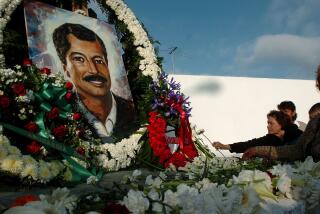Op-Ed: New Mexicans push a Spanish conquistador off his pedestal
In these troubled times, it was a moment of pure poetry.
On Monday, a 19-year-old Pueblo Native American man named Than Tsídéh jumped up on a pedestal and started dancing. The space had just been vacated by a 3-ton bronze statue of Juan de Oñate, which had stood there for nearly 30 years in the small northern New Mexican town of Alcalde, just outside Espanola.
Oñate (1550-1626) was a Spanish conquistador who established the colony of New Mexico for Spain and became its first governor in 1598. He is remembered for the Acoma War of October 1598, when his men demanded supplies from the Acoma Pueblo. The pueblo, needing provisions to survive the coming winter, refused, and in the ensuing conflict 11 Spaniards, including Oñate’s nephew, were killed.
Furious, Oñate ordered the pueblo destroyed in what became known as the Acoma Massacre; 800 to 1,000 Pueblos died in the siege. The survivors, approximately 500, were put on trial, and Oñate rendered the sentence: All men and women older than 12 would be enslaved for 20 years, and Spanish soldiers were instructed to chop off one foot of every man over 25 years old.
In all, 24 men lost one of their feet, condemned to totter on a stump for the remainder of their lives. Oñate was recalled to Mexico City in 1606 to account for his conduct, where he was convicted of cruelty to both natives and colonists and banished from New Mexico for life.
Except for that statue. The conquistador on a steed, wearing military regalia, looming over New Mexico Highway 68 at the Oñate Monument and Resource Center. In December 1997, on the eve of the 400th anniversary of Oñate’s arrival in the region, someone sawed off the monument’s right foot and left a note saying, “Fair is fair.”
It should be said that not everyone in northern New Mexico opposed the statue. Some residents, many of whom claim to be descendants of Oñate, pointed to it as a source of pride.
But in the midst of an awakening of the nation’s conscience after the killing of George Floyd on May 25, Oñate’s brutality was once again up for discussion. A petition to remove the Alcalde statue circulated, noting that “Onate perpetuated cruel and inhumane violence against the Pueblos and was prosecuted and exiled by the Spanish for war crimes.”
Red Nation, a Native American social justice organization, called for a demonstration at the statue on Monday. In the meantime, however, a Rio Arriba County official ordered the statue removed to storage for safekeeping, its ultimate fate still to be decided. (A similar fate befell another, newer Oñate bronze removed for its own protection from outside the Albuquerque Museum on Tuesday.)
“For the first time in many years, we don’t have to stare at Oñate,” Elena Ortiz, a Red Nation leader, told the Santa Fe New Mexican. “The presence of that statue was an act of violence upon Pueblo people from the moment it was put up and now, finally, it’s gone.”
The state’s governor, Michelle Lujan Grisham, in what was either a brilliant pun or an egregious malapropism, tweeted that the Alcalde statue’s removal was “a step in the right direction.”
When Than Tsídéh, whose name means Sun Bird in the Tewa language, arrived at the Oñate monument, ready to protest, the statue of the Pueblos’ tormentor was gone.
“I started to sing,” he explained, his long hair flowing in the breeze, “in honor of my ancestors who I know were slaughtered by this man.”
And then Than Tsídéh did what his long-ago ancestors, because of Onate’s cynical brutality, could not. He danced.
Randall Balmer, currently working from Santa Fe, teaches religion at Dartmouth College.
More to Read
A cure for the common opinion
Get thought-provoking perspectives with our weekly newsletter.
You may occasionally receive promotional content from the Los Angeles Times.






